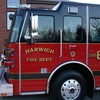Steps Taken To Avoid Future Water Contamination
HARWICH – The town is taking steps to avoid a repeat of last week’s water system contamination that resulted in a Do Not Drink order being issued.
Fire Chief David LeBlanc is changing the department’s policy and standards on use of firefighting foam after the material back-flowed into the water system during a fire April 9, causing more than 300 homes in North Harwich to rely on bottled water for a day.
LeBlanc on Tuesday said foam operations will only be conducted off tank water. If hoses are connected to a hydrant, the water supply from the hydrant will be shut down while applying foam. When refilling the tank, the foam system will be turned off.
“Now that we know the system can back feed into the water supply, we cannot take the risk of that happening again in the future, even though the circumstances for last week’s event was the perfect storm of factors that allowed it to occur,” said LeBlanc.
“Whatever happened the other day, we’re going to make sure it doesn’t happen again,” said LeBlanc.
The ban on use of town water in North Harwich was lifted last Thursday afternoon.
Water/Wastewater Superintendent Dan Pelletier said three samples sent to a laboratory on April 10 showed no evidence of the foam suspected of contaminating the system. Results received Tuesday from five additional samples sent later in the week showed no contamination.
"We're in good shape," said Pelletier.
Firefighting foam used to extinguish a blaze on Great Western Road in Dennis on the morning of April 9 was believed to have contaminated parts of the Harwich public water supply. LeBlanc said a Harwich engine was being fed from two different water sources — one in Harwich, one in Dennis — and those sources had different pressures. When the firefighters weren’t flowing water on the fire, the pressure from the Dennis water system caused the foam solution to back feed into the Harwich water system.
“In total 25 gallons of foam was used at the fire and most of it was used in and around the fire building, however apparently enough was back fed into the system to cause the problem that was discovered,” he said in a statement.
On Wednesday morning, the town issued a Do Not Drink order for the entire town; the order was later narrowed to portions of North Harwich. Some residents reported that their water had an odd coloration and appeared foamy.
The firefighting foam is biodegradable and does not include the forever chemicals per- and polyfluoroalkyl substances (PFAS), but should not be consumed. On Tuesday night, Harwich Water Department crews began flushing out the system.
Bottled water was distributed to residents of the impacted area on Wednesday at the Family Pantry of Cape Cod and on the following day from the Treasure Chest, located at the town transfer station. The town also provided water in bulk for some livestock owners in the village. Officials estimated that a maximum of 354 homes were affected by the order.
Pelletier said at the time the foam was introduced into the system, the water system pumps had been shut off, thus preventing circulation of water in the system. Had the pumps been on at the North Westgate well, it would have been more likely that the contamination could have spread into the wider water system, he said.
The Lothrop Avenue water storage tank pushes water to the west to the dead end of the system at the Dennis town line, so any foam in the system would have been contained in the stretch of water main between the town line and the Lothrop tank, Pelletier said. A second value was also shut off on the other water main in the area, prohibiting the flow of water into the system.
He estimated about 500,000 gallons of water were in the water mains. The department flushed a million gallons of water to ensure no foam remained in the system, he said.
“Only 25 gallons of foam was used and we believe a minimum amount of it entered the water system. Twenty five gallons to hundreds of thousands of gallons of water, the ratio is very low,” Pelletier said.
Alan Pollock contributed to this report.
Please support The Cape Cod Chronicle by subscribing today!
You may also like:


